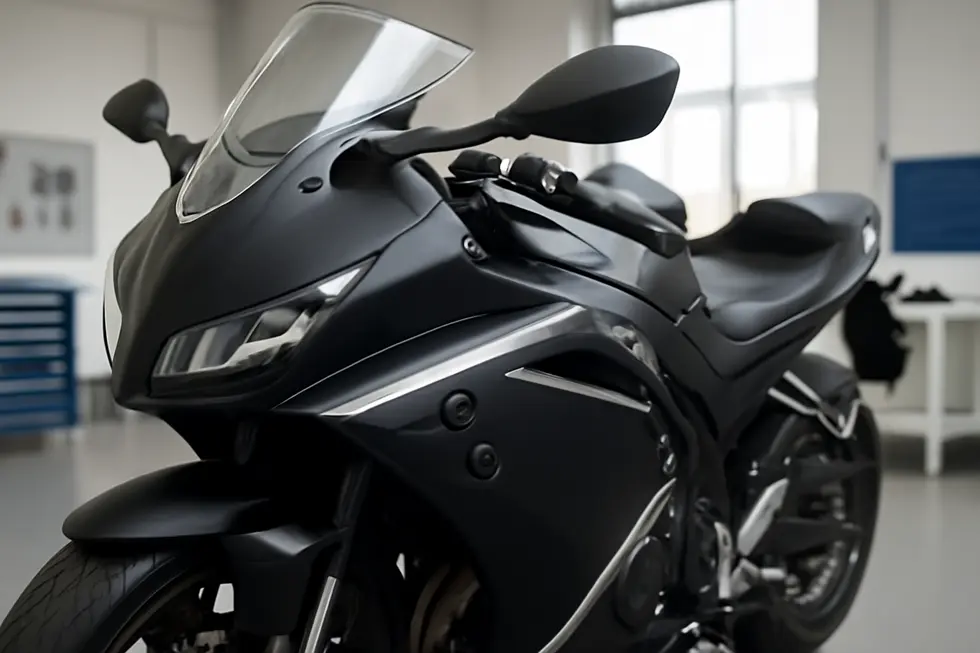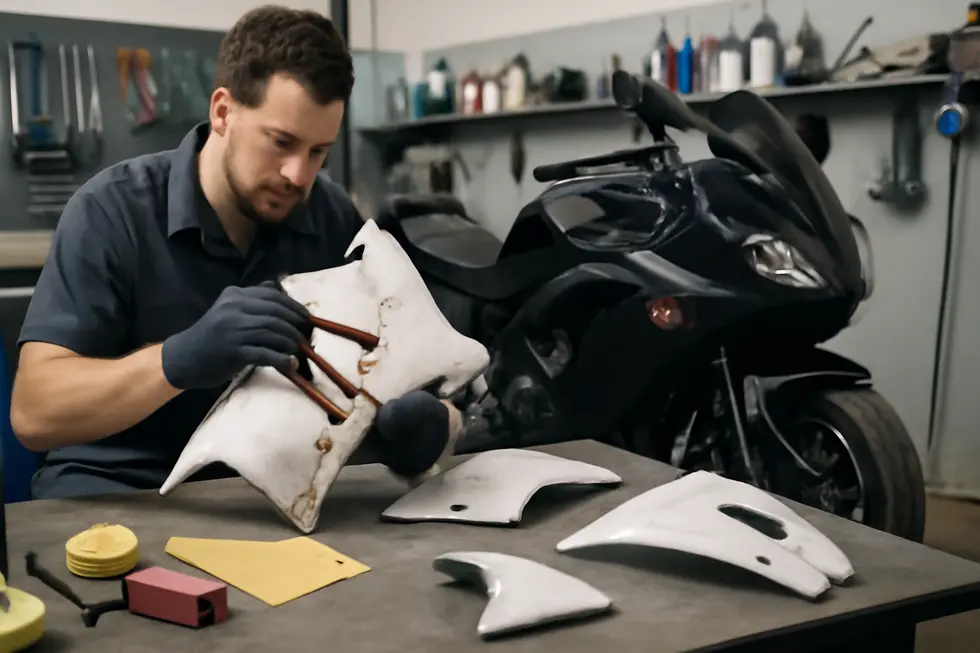Fairings for Motorcycles: Advancing Performance, Protection, and Style
August 18, 2025 | by summitfairings
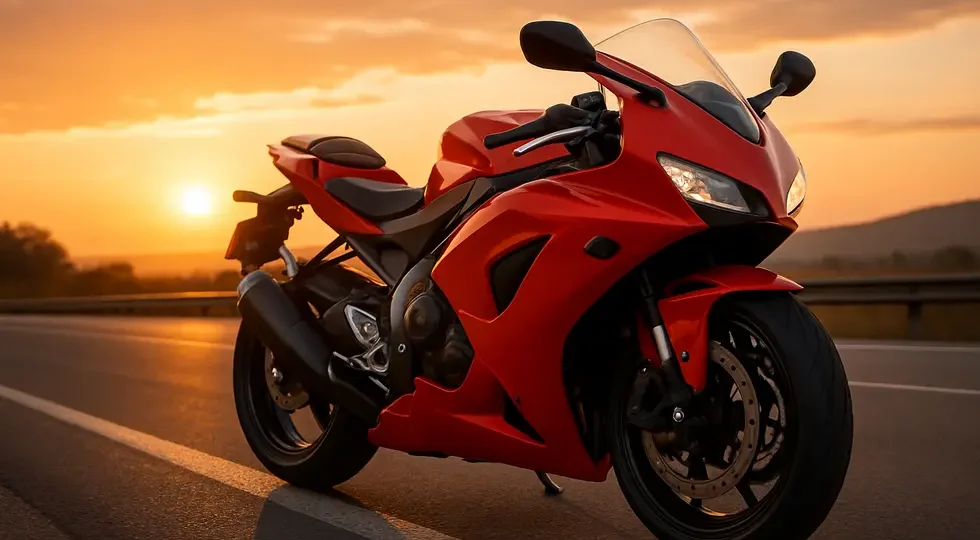
Introduction
Motorcycle fairings represent a vital intersection of engineering, design, and rider experience. Functioning not only as aerodynamic enhancers but also offering protection and aesthetic appeal, fairings impact performance, maintenance, and brand identity. For business owners in the motorcycle aftermarket industry, understanding the variety of fairing types, materials, manufacturing processes, and current market innovations is essential to meeting evolving customer demands. The first chapter delves into the distinct types and functional roles of fairings, highlighting how each configuration addresses specific rider and performance needs. The second chapter focuses on the materials and manufacturing techniques that underpin quality, durability, and cost-efficiency in fairing production. Finally, the third chapter explores modern innovations—including integrated lighting and premium materials—along with an overview of market leaders driving industry standards and trends.
Tables of Contents
Chapter 1: Types and Functional Roles of Fairings for Motorcycles
- How Motorcycle Fairings Enhance Aerodynamics and Rider Protection
- Innovative Materials and Structural Technologies Elevating Motorcycle Fairings’ Performance and Protection
- Blending Style and Function: How Motorcycle Fairings Define Identity and Personal Expression
- Enhancing Rider Safety and Visibility Through Fairing Design and Integrated Features
- How Economic and Market Trends Shape the Evolution and Functions of Motorcycle Fairings
Chapter 2: Materials and Manufacturing Techniques in Fairings for Motorcycles
- Optimizing Fairing Materials for Strength, Weight, and Durability in Motorcycle Design
- From Traditional Hand Lay-Up to Precision Injection Molding: Crafting Motorcycle Fairings with Advanced Manufacturing Techniques
- Balancing Performance, Cost, and Durability: Fiberglass, Carbon Fiber, and ABS Plastic in Motorcycle Fairings
- The Crucial Role of Fairing Stays: Merging Structural Integrity and Aerodynamic Precision
- Advanced Surface Treatments for Motorcycle Fairings: Balancing Durability and Visual Excellence
Chapter 3: Modern Innovations and Market Leaders in Fairings for Motorcycles
- Precision Aerodynamics: How Cutting-Edge Fairings Redefine Motorcycle Performance and Comfort
- Cutting-Edge Materials Shaping Performance and Design in Motorcycle Fairings
- Smart Integration: Advancing Performance and Connectivity in Motorcycle Fairings
- How Regional Market Trends Shape Innovation and Leadership in Motorcycle Fairings
- Emerging Technologies and Sustainable Design Shaping the Future of Motorcycle Fairings
Chapter 1: Types and Functional Roles of Fairings for Motorcycles
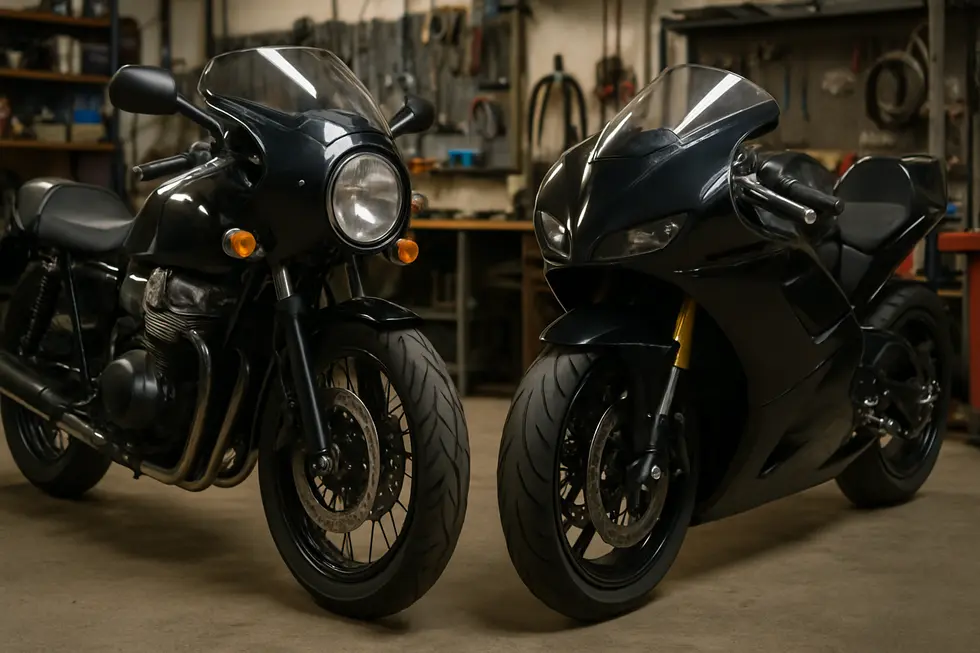
1. How Motorcycle Fairings Enhance Aerodynamics and Rider Protection
Motorcycle fairings play a crucial role in enhancing both aerodynamic efficiency and rider protection. By streamlining airflow around the bike and rider, fairings significantly reduce drag, which directly improves speed, fuel efficiency, and overall performance. Designs that incorporate advanced aerodynamics, such as integrated wings or carefully contoured surfaces, generate downforce to stabilize the motorcycle at high speeds. This reduces front-wheel lift, enhances braking stability, and allows more confident cornering. For instance, some modern sport bike fairings create a calm air bubble around the rider, mitigating wind buffeting and lessening rider fatigue during long or high-speed journeys.
Beyond aerodynamics, fairings shield riders from wind, rain, road debris, and intense engine heat. Wind deflection reduces physical strain over extended rides, improving comfort especially on touring and cruiser motorcycles. Additionally, fairings improve thermal management by optimizing radiator airflow and extracting heat from engine areas, supporting enhanced cooling on track-focused or performance machines. The protective aspect extends to durable materials resistant to impacts, abrasion, and corrosion, ensuring longevity even in harsh conditions.
Different fairing types balance these functions according to their intended use. Full fairings offer comprehensive coverage for maximum aerodynamic gain and protection, ideal for sport and touring bikes. Conversely, partial fairings like bikini or batwing styles focus on reducing wind fatigue and adding style without sacrificing accessibility or the motorcycle’s iconic character. Many fairings now integrate functional features such as lighting or vents that combine safety with aerodynamic benefits. Together, these attributes underscore fairings as essential components engineered to both optimize motorcycle dynamics and safeguard riders from environmental challenges.
For riders seeking deeper insights into the technology behind the most effective aerodynamic designs, exploring advanced motorcycle fairings reveals a broad range of options tailored to performance and protection.
Learn more about aerodynamic innovations in motorcycle fairings in the Ducati Panigale V4 Fairing Review.
2. Innovative Materials and Structural Technologies Elevating Motorcycle Fairings’ Performance and Protection
Motorcycle fairings are no longer just aesthetic add-ons—they represent a fusion of advanced materials science and structural innovation that heighten both performance and rider safety. Modern fairings increasingly incorporate recycled carbon fiber composites, offering exceptional strength-to-weight ratios that significantly reduce drag while contributing minimal weight. These eco-conscious composites demonstrate the industry’s shift towards sustainability without compromising durability or rigidity. Alongside carbon fiber, natural fiber composites such as unbleached flax fiber are being introduced in components like fenders. These natural fibers bring an environmentally friendly alternative that maintains mechanical robustness, blending ecological responsibility with functional design.
Complementing composite materials, lightweight metals—particularly high-grade aluminum alloys in the 6000 series—are integrated selectively in protective elements like crash bars. These metals afford critical engine protection and crash resilience while adding minimal mass, thus enhancing overall motorcycle agility and responsiveness. Advancements in structural engineering have also led to fairings featuring engineered geometries, such as hexagonal matrix structures. These designs optimize airflow, shielding vital components like radiators and oil coolers from debris without restricting cooling efficiency, exemplifying the balance between aerodynamic performance and component protection.
The composite and metal materials work synergistically to serve multiple functional roles. Fairings act as aerodynamic shells that minimize drag and improve fuel efficiency, while certain structural elements contribute to frame rigidity, enhancing handling precision. The tailored use of technology-driven materials and engineered forms ensures that modern fairings excel beyond mere visual appeal, firmly establishing their place as integral components that deliver elevated protection, reduced weight, and environmental sustainability. For riders seeking both high-performance efficiency and thoughtful material innovation, understanding these advances offers insight into how fairings continue to evolve in purpose and design.
Learn more about the latest developments and sustainable advancements in motorcycle fairings at the insightful Summit Fairings blog.
Reference: Fairing aerodynamic technologies utilizing engineered hexagonal matrix structures.
3. Blending Style and Function: How Motorcycle Fairings Define Identity and Personal Expression
Motorcycle fairings extend far beyond their fundamental roles of reducing drag and protecting the rider; they also serve as a crucial canvas for aesthetic expression and personalization. The distinctive lines, curves, and overall shapes of fairings contribute decisively to a motorcycle’s visual identity, often reflecting the character and heritage of the manufacturer or model. This interplay between form and function shapes how riders connect emotionally with their machines, making fairings central to a bike’s style appeal.
Modern fairings increasingly incorporate integrated lighting elements that enhance both aesthetics and safety. For instance, strategically placed LEDs within vents or mirrors add a contemporary flair while improving visibility. Such lighting features often offer dual functionality—combining daytime running lights with turn signals—seamlessly merging practical needs with stylistic upgrades. This integration is particularly evident in cruiser-style models where visual presence and road awareness are equally emphasized.
Customization possibilities further unlock personal style, allowing riders to tailor color schemes, graphic overlays, and logos to their preferences or affiliations. Aftermarket fairing components frequently arrive unpainted, providing an ideal foundation for bespoke finishes that either harmonize with or boldly transform the original look. Accessories like side covers with added utility features exemplify how these modifications can enhance both form and function without compromising aerodynamic integrity.
Many customization parts are designed to fit precisely with factory bodywork, preserving the seamless aerodynamic profile while enabling individual expression. This balance maintains the performance advantages of well-engineered fairings while offering an accessible route to unique styling.
Ultimately, fairings act as a dynamic interface between engineering and artistry, where improved rider comfort and efficiency coexist with bold visual statements. This makes them an essential consideration for riders seeking performance that reflects their personal identity.
For detailed options on customizing motorcycle fairings with premium finishes and styles, visit Explore the Best Motorcycle Fairings at Summit Fairings.
Source: Ducati Panigale V4 aerodynamics and ergonomic details.
4. Enhancing Rider Safety and Visibility Through Fairing Design and Integrated Features
Motorcycle fairings are more than just aerodynamic aids or style components; they play a pivotal role in enhancing rider safety and visibility. By minimizing wind pressure and shielding riders from debris and harsh weather, full fairings offer substantial protection that reduces fatigue and improves overall ride stability—especially at higher speeds. This aerodynamic advantage is further balanced by half and quarter fairings, which provide varying degrees of wind deflection while allowing easier access for maintenance or a lighter feel.
Beyond physical protection, modern fairings increasingly incorporate advanced integrated lighting systems to boost safety. LED technology is widely used to combine bright daytime running lights (DRLs) with amber turn signals within the same housing, delivering high-visibility signals without bulky, separate components. This streamlined integration not only enhances appearance but critically increases the motorcycle’s visibility to other drivers during both day and night. On certain cruiser styles, such as those featuring batwing fairings, dual-function LEDs smartly blend running lights and turn indicators to elevate both safety and aesthetic appeal.
Additional safety improvements are realized through subtle design choices like embedding indicators within headlights or enhancing windscreens for superior wind protection, contributing to rider comfort and control. Protective accessories such as frame sliders, crash bars, handguards, and headlight shields complement fairings to further safeguard the bike and rider from environmental hazards or minor collisions.
Customization also intersects with safety, as riders can personalize colors and designs while maintaining or introducing these critical integrated features. This flexibility ensures that fairings meet individual preferences without sacrificing vital protective functions.
Overall, fairings serve as essential safety-enhancing components that combine aerodynamic efficiency with innovative visibility solutions. They adapt to distinct riding styles and requirements, providing riders with tailored protection and signaling capabilities that contribute significantly to safer journeys.
For a deeper look at options that balance style with functional safety features, explore the array of motorcycle fairings available that cater to diverse rider needs.
External reference: Safety and lighting integration in motorcycle fairings
5. How Economic and Market Trends Shape the Evolution and Functions of Motorcycle Fairings
The landscape of motorcycle fairings in 2025 reflects dynamic economic and market influences that shape both their types and functional roles. As consumer expectations mature, riders increasingly seek premium experiences beyond basic protection and aerodynamics. This demand fuels the rise of fairings that blend sleek, minimalist designs with integrated technology—highlighting a shift from solely utilitarian components to sophisticated accessories that emphasize form and function together.
Advancements in smart technology have begun redefining fairing roles, accommodating electronics like Bluetooth, diagnostic sensors, and software-driven ride analytics within their structures. This has led to innovative design challenges, ensuring fairings maintain aerodynamic efficiency while housing sensitive components, particularly in emerging electric motorcycles. These electric models emphasize aerodynamic optimization to extend battery range, while incorporating features such as amplified audio systems to compensate for quieter operation.
Simultaneously, thriving customization cultures worldwide encourage varied fairing styles—from retro minimalism to contemporary sportiness—addressing diverse rider identities and aesthetic tastes. This trend intersects with rapid growth in Asian markets, where expanding middle classes drive demand for both affordable, functional fairings and premium, aspirational designs that mirror global trends.
Moreover, regional preferences influence material and design priorities, balancing durability, weather resistance, and cultural values reflected in brand identities. As a result, fairings now serve as both protective shells and expressive canvases that support technological innovation and personalization alike.
In essence, economic growth, electrification, and a growing focus on experience over mere utility are steering fairing development toward multifunctional, tech-savvy, and stylistically versatile designs that enhance rider engagement and performance.
For a deeper look at diverse fairing styles and their customization possibilities, explore Summit Fairings’ comprehensive offerings.
Chapter 2: Materials and Manufacturing Techniques in Fairings for Motorcycles
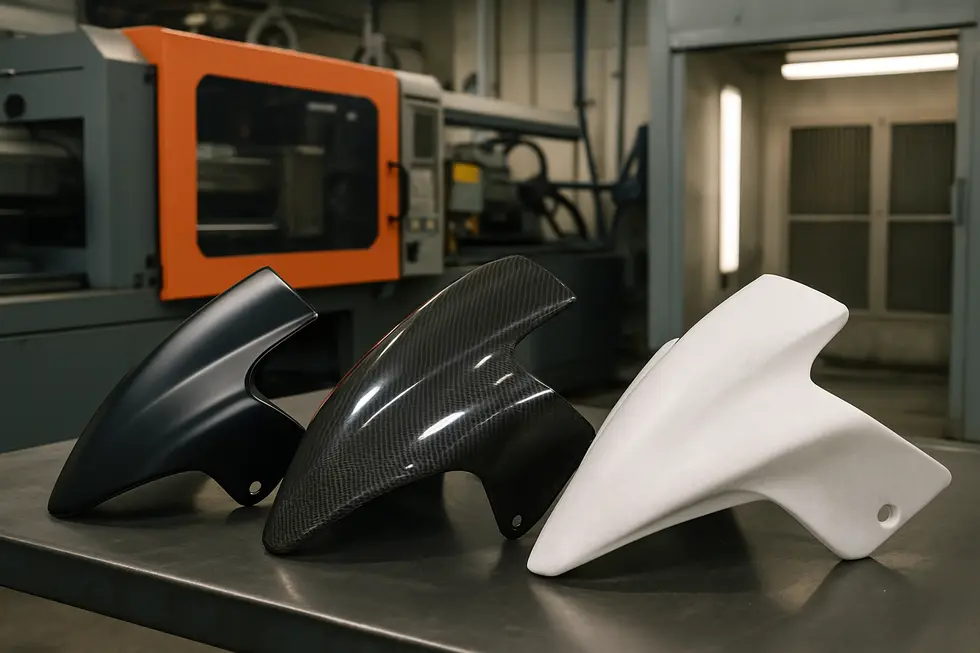
1. Optimizing Fairing Materials for Strength, Weight, and Durability in Motorcycle Design
Motorcycle fairings rely heavily on materials that perfectly balance lightweight properties with strength and durability to ensure peak performance and rider protection. Among the most prevalent materials, high-grade ABS plastic stands out due to its remarkable combination of toughness and flexibility. Manufactured using precision injection molding, ABS allows for exact fitment, essential for seamless integration with the bike’s frame and components. Its resilience to impacts and environmental wear makes it the preferred choice for mass-produced OEM-style fairing kits, providing not only mechanical protection but also ease of maintenance and longevity under varied road conditions.
For riders and manufacturers prioritizing performance and weight savings, carbon fiber composites offer a compelling alternative. These composites boast an exceptional strength-to-weight ratio significantly surpassing most plastics. The advanced manufacturing processes involved, such as prepreg layering and resin infusion, produce stiff, lightweight panels designed for racing or high-performance motorcycles where every gram counts. However, this premium material comes with higher costs and complexity in fabrication.
To enhance surface quality and visual appeal, ABS fairings often undergo sophisticated multi-stage painting procedures involving primers, multiple layers of durable paints, decals, and clear coats. This treatment not only elevates aesthetics but also fortifies the fairings against UV damage, abrasions, and weather exposure. Additionally, some aftermarket kits emulate carbon fiber’s distinctive weave pattern and texture to combine visual flair with the practical benefits of ABS.
Ultimately, the material choice reflects a strategic compromise between cost efficiency, manufacturing scalability, and tailored performance. While ABS plastic remains the dominant solution for everyday riders seeking durability and style, carbon fiber composites serve niche applications demanding cutting-edge weight optimization. This synergy of material science and manufacturing ensures modern motorcycle fairings meet diverse functional and stylistic rider needs.
For those interested in exploring a wide range of fairing options crafted from these advanced materials, visiting an expert source on aftermarket motorcycle fairings can provide detailed selections and insights into material benefits.
External Reference: https://www.rp-advancedcomposites.com/carbon-fiber-top-advantages
2. From Traditional Hand Lay-Up to Precision Injection Molding: Crafting Motorcycle Fairings with Advanced Manufacturing Techniques
The manufacturing journey of motorcycle fairings has evolved significantly, blending craftsmanship and modern technology to achieve superior performance and aesthetics. Traditional methods like the hand lay-up process remain vital for producing custom or low-volume fairings. In this technique, skilled technicians carefully place layers of fiberglass or carbon fiber into molds before impregnating them with resin. Though labor-intensive, hand lay-up allows for bespoke shapes and detailed finishes tailored to specific rider needs or prototype experimentation.
Parallel to this, rapid prototyping technologies such as Stereolithography (SLA), Selective Laser Sintering (SLS), and Fused Deposition Modeling (FDM) have become indispensable tools in the design phase. SLA offers incredibly smooth and aerodynamic prototypes, enabling precise testing of airflow and drag reduction. Meanwhile, SLS supports complex internal geometries that contribute to lightweight yet strong structural components, while FDM is often employed for ergonomic seat and accessory prototypes to optimize rider comfort and fit. These additive manufacturing techniques expedite design validation and significantly reduce development cycles.
For mass production, precision injection molding stands out as the industry standard, especially for fairings made from ABS plastic. By injecting molten plastic into finely machined molds, this process guarantees exact OEM fitment, consistent quality, and excellent surface finish. Injection molding supports high-volume output while producing durable, impact-resistant fairings that retain their shape and color. Recently, silicone mold technology has emerged as a flexible alternative, offering enhanced detail and reduced material waste. This innovation aligns with industry demands for sustainable production and intricate design fidelity.
Together, this spectrum of manufacturing methods—from handcrafted composites through cutting-edge prototyping to efficient high-volume molding—reflects the continuously advancing landscape of motorcycle fairings. Riders benefit from fairings that perfectly balance form and function, made possible by these sophisticated techniques. For further insight into the variety and quality available, explore the extensive choices in motorcycle fairings at Summit Fairings.
3. Balancing Performance, Cost, and Durability: Fiberglass, Carbon Fiber, and ABS Plastic in Motorcycle Fairings
The choice among fiberglass, carbon fiber, and ABS plastic profoundly shapes the attributes of motorcycle fairings, impacting everything from weight and durability to manufacturing complexity and cost. Fiberglass, favored in budget and mid-tier segments, is created by layering glass fibers with resin in molds. This hand lay-up process yields a heavier but sturdy material that excels in affordability and ease of repair. Its flexibility in shaping and cost-effectiveness make it popular for hybrid kits that combine fiberglass uppers with ABS lowers, balancing performance and price.
Carbon fiber stands at the premium end, formed by precisely laying woven fibers into resin and curing them—sometimes under autoclave conditions—to achieve exceptional stiffness and ultra-lightweight strength. These fairings serve riders who demand superior aerodynamics and minimal weight, such as track competitors. The manufacturing is intricate and costly, but the material’s performance advantages are unmatched. Its aesthetic also conveys a high-performance image, often unalloyed by other materials to maximize these benefits.
ABS plastic, molded through high-volume injection processes, offers a different set of benefits. It delivers good impact resistance, flexibility, and consistent OEM-like fitment at a moderate price point. Though less rigid than fiberglass or carbon fiber, ABS’s ability to absorb stress without cracking makes it highly practical for everyday use and easier installation. It is often finished with carbon fiber-like patterns to mimic premium looks without the associated cost.
Manufacturers often combine these materials to harness their strengths—ABS for its installation ease, fiberglass for cost-effective durability, and carbon fiber for high-performance weight savings. This hybrid approach supports a wider range of rider needs and budgets. Understanding these material distinctions clarifies how fairings blend engineering, artistry, and economics into components that enhance both performance and style. For riders seeking a deeper dive into aftermarket fairings and their applications, exploring summit fairings offers comprehensive insights.
4. The Crucial Role of Fairing Stays: Merging Structural Integrity and Aerodynamic Precision
Motorcycle fairings rely heavily on fairing stays to maintain their structural integrity and aerodynamic profile. These essential supports connect the body panels securely to the frame, preventing vibration-induced damage and ensuring the panels remain perfectly aligned through dynamic riding conditions. This stability preserves the smooth airflow crucial for reducing aerodynamic drag, directly impacting the motorcycle’s speed and handling.
Fairing stays are designed from materials that balance strength and weight, commonly aluminum alloys for their lightness paired with sufficient mechanical resilience, or carbon fiber composites when performance demands push for maximum weight savings and rigidity. Durable plastics like reinforced ABS can also be used where cost efficiency is a priority. The choice of material affects how effectively stays withstand forces from wind pressure and road vibrations without deforming or fatiguing over time.
Manufacturing processes integrate advanced rapid prototyping methods such as stereolithography (SLA) to rapidly test and refine stay designs for optimal fit and aerodynamic efficiency before committing to mass production. For mass-produced stays, injection molding for plastic components and composite layup techniques for carbon fiber ensure precision, consistent quality, and robust performance. Designers carefully streamline stay profiles and position them to minimize airflow disruption, often embedding stays behind panels or within fairing contours to avoid generating turbulence that could degrade performance.
This fusion of thoughtful material selection and sophisticated manufacturing techniques enables fairing stays to not only provide mechanical support but also to actively preserve and enhance aerodynamic benefits. By securing the fairings properly and blending into the motorcycle’s streamlined shape, stays contribute significantly to durability, rider safety, and the overall riding experience.
For riders seeking a deeper understanding of fairing structural solutions, explore expert insights on motorcycle fairings.
External resources on rapid prototyping in motorcycle fairing design provide further detail: https://www.mold7.com/applications/motorcycle-mold
5. Advanced Surface Treatments for Motorcycle Fairings: Balancing Durability and Visual Excellence
The longevity and appeal of motorcycle fairings depend heavily on meticulous surface treatment and finishing processes tailored to their materials. Before any coating, fairings undergo thorough cleaning and sanding to remove dirt and establish a textured surface that promotes strong paint adhesion. For plastic components, an adhesion promoter is vital to ensure primers bond effectively, preventing peeling or flaking. Following this, a two-component primer is applied to create a resilient base layer that safeguards the paint and helps avoid chip damage during rides.
Painting is performed with multiple thin coats rather than a single thick one, ensuring even coverage and avoiding runs. Proper mixing ratios of paint and reducers, along with environmental controls during application, contribute to a flawless finish. To shield this delicate paint layer from ultraviolet radiation, scratching, and environmental exposure, several clear coats are layered on. These not only preserve the color and gloss or matte effect but also add mechanical strength to the finish. Adequate curing time before handling is essential to attain maximum durability.
Beyond traditional coatings, advanced techniques such as ceramic coating introduce microscopic layers that enhance scratch resistance and chemical immunity without compromising matte or glossy finishes. The prep phase for ceramic application requires specialized sprays, avoiding aggressive solvents that might impair bonding. Another modern protective solution is paint protection film (PPF), a transparent, durable layer applied over painted surfaces to absorb minor impacts and prevent fading. Professional installation with wet application methods is paramount to avoid blemishes or bubbles.
Regular inspection for cracks or damaged mounts is crucial since compromised fairings pose safety risks. These comprehensive finishing methods, paired with routine maintenance, extend fairing life and maintain their aesthetic presence under varied riding conditions. For guidance on painting techniques for plastic fairings, resources like the tutorial videos at Ride or Die Motorcycles offer practical support, while insights into ceramic coatings and PPF installation come from expert demonstrations such as McKee’s37 and Urban Werks respectively.
For further exploration of durable and visually striking motorcycle fairings, see the detailed insights available in the explore the best motorcycle fairings at Summit Fairings blog.
Chapter 3: Modern Innovations and Market Leaders in Fairings for Motorcycles
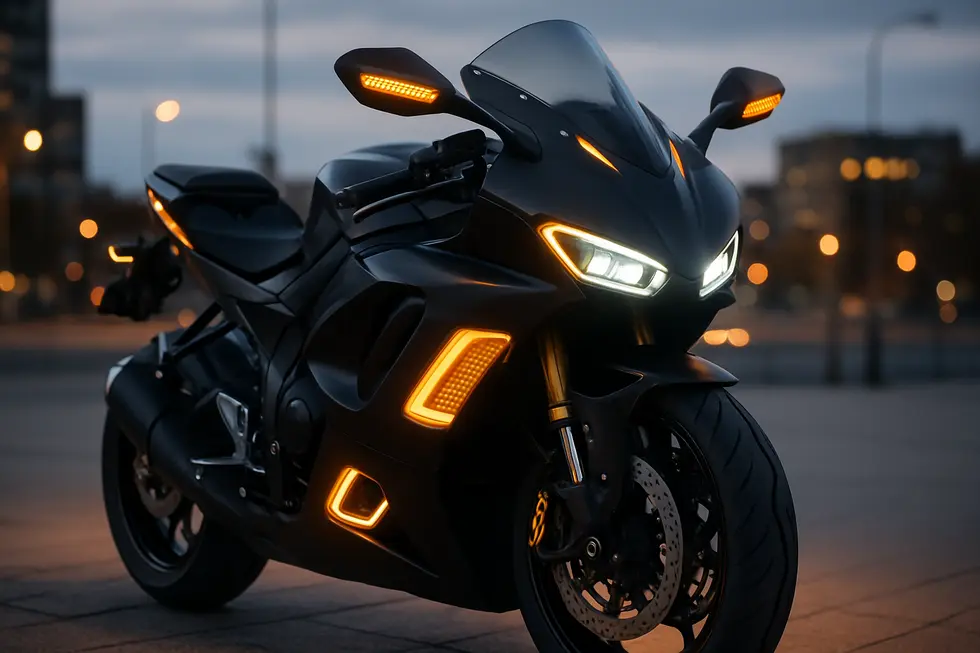
1. Precision Aerodynamics: How Cutting-Edge Fairings Redefine Motorcycle Performance and Comfort
Precision Aerodynamics in Motorcycle Fairings: Enhancing Performance and Rider Experience
Modern motorcycle fairings represent the culmination of advanced aerodynamic engineering aimed at reducing drag, optimizing airflow, and improving rider comfort. Leading innovations merge sleek design with functional efficiency, often developed through collaboration with aerodynamics specialists and racing experts. This multidisciplinary approach ensures fairings not only deflect wind to minimize resistance but also create downforce that stabilizes the bike at high speeds.
High-performance models exemplify this integration. Designs inspired by competitive racing envelop the front, sides, and undercarriage, crafting streamlined profiles that dramatically reduce turbulent airflow. A prominent example recently demonstrated how wind tunnel testing and precise clay modeling enabled a 4% reduction in rolling resistance without compromising critical elements like radiator cooling or rider protection. Such balance is essential to ensure thermal management while maintaining aerodynamic gains.
Material innovation further elevates aerodynamic optimization. Lightweight composites allow fairings to maintain strength and durability while decreasing weight, which enhances acceleration and handling. This is particularly crucial as electric motorcycles enter the market; their unique thermal and aerodynamic demands drive the creation of fairings that manage airflow and heat dissipation simultaneously.
Touring motorcycles also benefit from these advancements. Redesigned fairings integrate aggressive yet functional shapes that reduce wind buffeting and noise, dramatically enhancing rider endurance over long distances. These designs blend form and function, proving that aerodynamic efficiency need not sacrifice visual appeal.
This confluence of design expertise, material technology, and thermal considerations illustrates how today’s market leaders push aerodynamic optimization beyond mere speed gains. They create safer, more comfortable, and visually striking motorcycles that elevate the riding experience. For riders interested in exploring a broad spectrum of aerodynamic and style options, Summit Fairings offers a valuable resource.
For deeper insight into race fairings and their aerodynamic impact, videos by external The Racing Xpert provide excellent visual explanations.
2. Cutting-Edge Materials Shaping Performance and Design in Motorcycle Fairings
Motorcycle fairings have entered a new era shaped by advanced material technologies that optimize performance, durability, and rider experience. Central to these innovations are lightweight composites, particularly carbon fiber, which deliver exceptional strength while significantly reducing weight. Being 30-40% lighter than traditional fiberglass or aluminum, carbon fiber fairings improve acceleration, handling, and fuel efficiency, especially vital for high-performance and racing motorcycles. They also provide high thermal resistance, enduring temperatures up to 250°C, assuring reliability in demanding environments.
Beyond material benefits, aerodynamic design has been seamlessly integrated with these modern composites. Fairings now feature sculpted contours and built-in airflow management systems that reduce drag by up to 20%, enhance engine cooling, and increase downforce, resulting in improved stability at high speeds. These aerodynamic solutions move beyond simple add-ons, such as bolt-on winglets, by becoming a cohesive part of the fairing’s structure, thus maximizing efficiency and stylistic refinement.
Manufacturing advancements complement these material and aerodynamic strides. Precision technologies like 3D milling and polyurethane foam shaping allow for personalized, intricate designs with embedded color and pattern options. This fusion of engineering and aesthetics meets the growing demand for customization, appealing to both manufacturers and riders seeking unique, high-quality fairings.
These material developments are driving market trends globally, with a notable surge in lightweight composite fairings adoption, especially in regions experiencing rising middle-class purchasing power and electrification of motorcycles. Full fairings dominated by carbon fiber and ABS plastic are projected to see substantial growth, reflecting the balance between cutting-edge technology and practical everyday use.
For further insights on material innovations and market trends, see the analysis on motorcycle fairing market trends and material recommendations.
This advancing material landscape underpins modern motorcycle fairings’ dual role: enhancing both performance and visual distinction, affirming their essential place in contemporary motorcycling.
Living With Gravity Suzuki GSX-R offers an in-depth look at the aerodynamic integration accompanying these material advancements.
3. Smart Integration: Advancing Performance and Connectivity in Motorcycle Fairings
Modern motorcycle fairings are evolving beyond traditional aerodynamic functions to become sophisticated hubs of performance-enhancing and safety-driven electronics. Leading manufacturers now integrate advanced materials with embedded smart technologies, transforming fairings into active components that interact dynamically with both the rider and the environment. One prominent innovation lies in aerodynamic design enhancements that double as functional tech. For example, integrated winglets sculpted into fairings generate downforce to improve stability at high speeds while simultaneously channeling airflow to critical cooling systems. This dual-purpose design reflects a deeper synergy between form and function that elevates track-level technology into street-ready solutions.
Beyond aerodynamics, embedded sensors and control units are integrated seamlessly within the motorcycle’s bodywork to enable lean-sensitive traction control and adaptive braking systems that modulate ABS during cornering. These sensor arrays, supported by inertial measurement units, heighten rider awareness and contribute to active safety features such as blind spot detection. This integration marks a shift from disparate electronic add-ons toward unified, fairing-embedded control systems enhancing real-time riding dynamics.
Connectivity and software adaptability further distinguish modern fairings, especially in electric motorcycles. Over-the-air updates allow continual refinement of ride analytics and predictive maintenance diagnostics, merging hardware with digital evolution. Such fairings also emphasize premium finishes and high-quality materials, moving past purely functional plastics to embody a refined, tech-forward aesthetic.
At industry events, smart technologies showcased include interactive vehicle consoles feeding live camera streams, adaptive cruise controls using millimeter-wave radar, and even coordinated rider gear linked electronically with the motorcycle. These advances illustrate a comprehensive approach where fairings serve as both protective shells and platforms for digital augmentation.
This trend toward embedding smart technology within the very contours of motorcycle fairings exemplifies how aerodynamic bodywork now plays a pivotal role in riding safety, performance, and connectivity. For enthusiasts seeking top-tier aftermarket solutions, exploring premium motorcycle fairing options offers insight into how smart integration can blend robust OEM-quality fitment with cutting-edge aesthetics and functionality.
For further reading on aerodynamic innovations like integrated winglet design, refer to details on the Ducati Panigale V4 innovations here.
4. How Regional Market Trends Shape Innovation and Leadership in Motorcycle Fairings
Regional dynamics play a pivotal role in steering innovations and determining market leadership within the motorcycle fairings sector. The Asia-Pacific region commands nearly half of global fairing sales, fueled by a surge in motorcycle ownership particularly in India and China. Rising disposable incomes and a burgeoning middle class have sparked heightened demand for sport motorcycles, which favor full fairings due to their superior aerodynamic efficiency. Manufacturers in this region strategically adopt localized design and marketing approaches, balancing cost-sensitive materials like ABS plastic with selective carbon fiber components to ensure quality and regulatory compliance.
Conversely, North America and Europe emphasize performance and sustainability through investments in advanced materials and integrated smart technologies. The mature markets here demand lightweight, aerodynamic fairings often crafted from carbon fiber hybrids, incorporating IoT-enabled safety features, embedded sensors, and sustainable composites. Stringent emissions and safety regulations accelerate adoption of such innovations, encouraging market leaders to blend functionality with eco-conscious design while catering to customization trends.
Emerging industry players leverage hybrid material kits that combine the strength of carbon fiber fronts with the affordability of ABS rear sections. This approach addresses global raw material cost fluctuations and supply chain complexities. Additionally, the rising popularity of electric motorcycles across regions encourages integration of audio systems within fairings, compensating for quieter engines and enhancing rider experience.
These regional market traits reflect diverse consumer preferences and regulatory landscapes. Asia-Pacific’s focus on affordability and compliance contrasts with North American and European investments in smart, sustainable technologies. Leading brands navigate these dynamics by expanding partnerships and evolving product lines to meet regional demands, driving steady market growth projected at a compound annual rate between 5.2% and 7.9% through 2030.
For riders and enthusiasts seeking to explore the variety of fairing innovations tailored for different markets, resources highlighting comprehensive aftermarket options offer valuable insight. More detailed regional analysis and projections can be found in specialized industry reports [4].
5. Emerging Technologies and Sustainable Design Shaping the Future of Motorcycle Fairings
The evolution of motorcycle fairings is increasingly shaped by advanced aerodynamic engineering and an urgent focus on sustainability. Leading manufacturers are moving beyond mere drag reduction to adopt holistic airflow management systems that optimize cooling and stability from the nose to the belly pan. This integrated aerodynamic philosophy not only enhances race-track performance but also improves everyday riding efficiency and rider comfort, embodying a seamless “Race-to-Road” transition.
Material innovation plays a crucial role in this transformation. While carbon fiber remains prized for its unmatched strength-to-weight ratio, the future favors eco-conscious sourcing and manufacturing. Emerging composites and bio-based polymers are gaining traction, aiming to reduce the carbon footprint without sacrificing durability or flexibility. Simultaneously, cutting-edge production techniques such as Motorcycle Silicone Mold technology enable higher precision and less waste, reflecting a commitment to sustainable manufacturing processes.
Customization trends also shape this landscape, with riders demanding fairings that combine striking aesthetics with functional enhancements. Textures like honeycomb patterns and realistic faux carbon finishes merge visual appeal with aerodynamic function. These design innovations prioritize ease of installation and long-term resilience, balancing style and practicality in a competitive market.
As the global motorcycle aftermarket approaches an $83 billion valuation by 2027, industry leaders are spearheading innovations that integrate performance, sustainability, and customization to meet diverse rider needs. The future of motorcycle fairings lies in this synergy of eco-friendly materials, aerodynamic efficiency, and personalized design, ensuring that advances benefit both the environment and the rider experience.
For riders seeking a broad variety of modern and sustainable fairing options, exploring the best motorcycle fairings at Summit Fairings offers insights into emerging trends and quality craftsmanship.
Final thoughts
Motorcycle fairings remain a cornerstone of both rider experience and motorcycle performance, balancing aerodynamic benefits, protection, and customization possibilities. For business owners, understanding the nuanced differences between fairing types, material choices, and ongoing technological innovations empowers smarter inventory decisions and better client guidance. By prioritizing quality manufacturing and integrating emerging trends such as LED lighting and advanced finishes, aftermarket suppliers can elevate their offerings and market position. The growing demand for durable, stylish, and performance-enhancing fairings underscores their evolving role—not just as accessories, but as essential components that define a motorcycle’s character and capability. Navigating this dynamic landscape with insights into types, materials, and market leaders positions businesses to capture opportunity and deliver value in a competitive industry.
Ready to elevate your ride? Summit Fairings delivers premium, custom-fit fairings that blend style and durability. Whether you’re chasing speed or turning heads, we’ve got your bike covered. Don’t wait—transform your machine today. Click, customize, and ride with confidence. Your perfect fairing is just a few clicks away. Act now!
About us
We are one of the leading motorcycle fairing export sites, with over 3,000 styles across almost all motorcycle models. Buy from summitfairings.com, and pay 10-40% less than the prices on other sites. If you have any questions, we promise we will have your answer within six hours.
RELATED POSTS
View all

